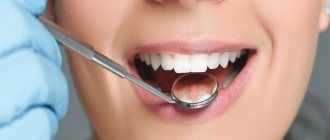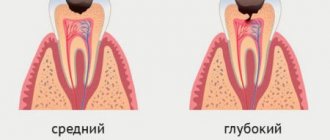This page is dedicated to those for whom any manipulation in the mouth, and sometimes even brushing their teeth, causes a pronounced gag reflex. In some people, this reflex is very sensitive and its zone expands right up to the front teeth, which creates certain difficulties during a dental appointment...
Let's try to figure out why this happens and how we can deal with it.
The gag reflex starts at the back of the throat. It prevents foreign objects from entering the respiratory tract. In some people, this reflex is very sensitive and its zone expands all the way to the front teeth. This creates serious difficulties during the dental appointment: difficulties in taking x-rays, applying cotton rolls, taking impressions, using a saliva ejector, treating posterior teeth or wearing removable dentures. What are the mechanisms of the gag reflex?
Two types of reactions that cause the gag reflex:
- physiological - response to mechanical stress, touch in the mouth;
- psychological - reactions associated with dental phobia.
Most often, a combination and mutual influence of both types of reactions is observed. The gag reflex can intensify with difficulty in nasal breathing, stomach diseases, at the sight of instruments, the smell of medicines or the sound of equipment. The degree of manifestation of the reflex varies for each person: from slightly pronounced to very severe.
For mild cases, the following may be effective:
- using a rubber dam when the oral cavity is isolated from the diseased tooth with a rubber curtain, and there is no danger of accidentally touching the palate or gum with instruments. But this technique is not always suitable for children, because... Some children have fear from having their mouth covered with a rubber scarf and “they won’t be able to breathe,” from a clamp, etc.
- psychological methods of distraction (music, TV);
- superficial anesthesia of the palate;
- use of antiemetic medications in the evening and an hour before administration;
- step-by-step retraining, which you can successfully do at home and get rid of the painful reflex forever.
- In moderate cases: many patients benefit greatly from treatment under sedation with nitrous oxide in combination with further treatment of dental phobia.
- In severe cases: when the reflex is strong and other approaches are ineffective, dental treatment is performed under anesthesia or intravenous sedation according to the principle “close your eyes, open your eyes, and the treatment is complete.”
Nausea, vomiting in women (including during pregnancy)
Nausea and vomiting, along with a throbbing headache, depressed mood, increased sweating and numbness of the hands, characterize the cephalgic form of premenstrual syndrome (PMS).
At the same time, blood pressure remains within normal limits. Unpleasant symptoms occur 2-10 days before menstrual bleeding in women with irregular cycles, a history of abortion or depression. Considering that the nervous system in women is more excitable than in men, nausea and vomiting during menstruation can be triggered by any unpleasant odor. Often, prolonged nausea without vomiting in women is a consequence of following a strict diet for a long time. The use of dubious food additives, a lack of essential microelements and vitamins, and the abuse of laxatives leads to chronic stress and disruption of the digestive tract. In addition to this, dysbacteriosis develops. The feeling of nausea goes away only after the intestinal microflora is normalized.
Nausea for no apparent reason is often the first sign of pregnancy. The unpleasant sensation is associated with a sharp increase in the level of the hCG hormone. Further hormonal changes in the female body, changes in metabolism and psychological stress often provoke vomiting 1-2 times a day, more often in the morning. The state of health returns to normal by the 13th week of pregnancy.
Early toxicosis (before 16-18 weeks of pregnancy)
- Mild degree - vomiting up to 5 times a day, the condition of the pregnant woman is satisfactory, the fetus is not in danger.
- Early toxicosis of moderate severity - vomiting up to 10 times a day, weight loss up to 3 kg, rapid pulse (up to 100 beats/min), acetone in the urine.
- Excessive vomiting of pregnancy (grade three) - vomiting up to 25 times a day, weight loss of more than 5%, dehydration and electrolyte imbalance. Immediate medical intervention is required.
Important! Severe vomiting in early pregnancy may indicate a hydatidiform mole.
Regularly occurring nausea and vomiting in late pregnancy makes one suspect the development of preeclampsia, the third stage of late toxicosis (preeclampsia). This condition is preceded by the appearance of swelling of the limbs and face (stage 1), increased a/d and protein in the urine (nephropathy, stage 2 of gestosis). Without timely treatment of preeclampsia, seizures (eclampsia) develop and the risk of stroke is high. For the fetus, late toxicosis is fraught with hypoxia, delayed development and perinatal pathologies. There is a high risk of placental abruption and premature birth.
Important! Nausea and vomiting in a pregnant woman can also be caused by taking iron supplements to treat anemia, common gastroenteritis, or another disease.
Causes of nicotine poisoning
Nicotine intoxication can be acute or chronic. The first is due to the intake of a large amount of tobacco toxins into the body over a short period of time. In the second form, cigarette poisoning occurs regularly when a person smokes too much tobacco daily
The reasons for the appearance of signs of acute intoxication may be:
- Smoking cigarettes on an empty stomach;
- Excess nicotine in the body (consuming a large dose of nicotine in a short period of time);
- Child eating tobacco;
- Combining anti-smoking products (patches, chewing gum, etc.) with nicotine and smoking cigarettes;
- Failure to comply with safety measures when working with insecticides containing nicotine, as well as in the production of tobacco products.
Chronic nicotine poisoning can occur not only in heavy smokers, but also in their family members who have to constantly inhale tobacco smoke. When smoking cigarettes, toxic compounds such as arsenic, hydrocyanic acid, and methanol are released into the air. They complicate poisoning both in smokers themselves and in “passive smokers” who inhale cigarette smoke.
REHABILITATION
Nausea and vomiting in children
Frequent regurgitation of infants in most cases is caused by gastroesophageal reflux (reflux of food into the esophagus due to incompetence of the lower sphincter). However, this condition has nothing to do with vomiting. A one-time gag reflex against the background of a normal general condition also does not require special attention. Repeated vomiting in a newborn often indicates illness.
- Pyloric stenosis (manifests at 3-12 weeks) - vomiting “fountain” soon after finishing feeding. Unlike systemic diseases, vomiting with pyloric stenosis does not contain bile, and the baby sucks the breast with appetite.
- Intestinal obstruction - occurs due to intestinal atresia, obstruction of the ileum by extremely viscous meconium (meconium ileus), volvulus, or intestinal stenosis. From the first days the baby suffers from vomiting, and the general condition rapidly deteriorates.
- Intussusception (3-36 months) - often caused by viral enteritis and leads to intestinal obstruction. Attacks of severe abdominal colic and vomiting every 15-20 minutes lead to ischemia of the intestinal area, gangrene and perforation.
Nausea and vomiting in a child can be caused by unusual foods, nervous stress and various odors.
The main causes of vomiting in older children:
- viral/bacterial gastroenteritis - often occurs with diarrhea and fever;
- influenza, acute respiratory infections, childhood infections (for example, scarlet fever) - against the background of a high temperature, the child often develops vomiting and convulsions are possible;
- helminthic infestation - the child complains of nausea without vomiting, the parents note that the child has bad breath, rumbling in the stomach, itching in the anus and grinding of teeth at night;
- errors in nutrition - too fatty, spicy or fried foods provoke nausea, diarrhea and sometimes vomiting without fever;
- appendicitis - pain can begin in the stomach, near the navel or lower in the right side, the child becomes lethargic and drowsy, any painkillers for abdominal pain are strictly prohibited;
- poisoning with drugs and household chemicals - often causes an extremely serious condition, the symptoms depend on the toxic substance;
- sunstroke (heatstroke) - when overheated, the body temperature rises to 40ºC, the skin turns red and sweats significantly, nausea/vomiting and headache occur, breathing and heart rate increase;
- taking antibiotics almost always provokes intestinal dysbiosis (feeling of nausea after eating without vomiting, loss of appetite, constipation/diarrhea). To maintain intestinal microflora, antibacterial courses are combined with the intake of probiotics.
Nausea and vomiting with coronavirus
Severe complications and high mortality with COVID-19 force us to more carefully study the first symptoms of the disease. The difficulty lies in the fact that the virus rapidly mutates, and the clinical manifestations of the disease also change. In 2021, typical symptoms of coronavirus infection were fever, loss of smell and taste, muscle pain, and only then a cough. Only some patients experienced nausea and vomiting a little later. In 2021, the majority of cases are caused by the Indian strain of COVID-19, which is characterized by higher infectiousness and a “stomach” syndrome. Against the background of fever and catarrhal symptoms (runny nose, sore throat, cough), every third patient with coronavirus experiences nausea/vomiting and pain in the stomach. A little later, diarrhea and hearing problems appear, and the sense of smell disappears less often.
The "Delta" strain most often affects young people and children. And previously worked out treatment regimens give a noticeably less effect. This is why vaccination of the population, including those who have previously had coronavirus, is so important. Although a two-time vaccination does not completely eliminate infection, it will help avoid severe disease, complications and death. Among the sick, the percentage of vaccinated people does not exceed 1%.
Important! Nausea after vaccination against coronavirus occurs in every tenth vaccinated person. Vomiting is a rare side effect. All unpleasant consequences of the vaccine disappear within 3 days.
The gag reflex is a manifestation of a phobia.
A phobia is a strong, literally panicky fear. It’s hard to disagree that many of us are afraid of treatment in the dentist’s chair. Often patients cannot even say what exactly causes fear: pain, tools? But sometimes treatment is not associated with pain at all, it is only a preventive examination or even a consultation, but fear is nevertheless present. Vomiting and phobia are manifestations that can greatly interfere with treatment and, to some extent, even affect its quality.
Scientists at West Virginia University conducted a study that involved about 500 patients. At dental clinics, patients were asked to answer a questionnaire while waiting for an appointment. More than 50% of respondents responded that during examination and treatment in the dentist’s chair they experienced the urge to vomit at least once, and even described the manipulation that provoked such sensations. About 8% of respondents noted that vomiting was present throughout the entire dental appointment. The urge occurs as soon as the patient opens his mouth.
Another question in the questionnaire was to describe your emotional state when visiting the dentist. Analysis of the data allowed us to conclude that the urge to vomit was most pronounced in patients with phobias of dentists and treatment.
Researchers recommend dentists be more attentive to the emotional state of patients, assess the degree of anxiety and find out the presence of phobias. Knowing about the predisposition to vomiting while working as a dentist will help him choose the right treatment tactics.
Specific features of nausea and vomiting
To identify the cause of poor health and assess the patient's condition, the duration of nausea and vomiting is important. Acute vomiting (1-2 days) is often caused by medications, infections, poisoning (such as alcohol), kidney damage, and diabetes. Chronic vomiting (more than 1 week) is characteristic of long-term gastrointestinal diseases and mental disorders.
Features of vomiting and nausea
- Vomiting immediately after eating is characteristic of stomach lesions. If the gag reflex occurs 2-3 hours after eating, pathology of the duodenum is possible.
- Nausea and vomiting of acid are observed with gastritis with increased secretion and stomach ulcers.
- Vomiting of bile (greenish-yellow color) is caused by pathology of the hepatobiliary system (liver, gallbladder) or pancreas.
- Bloody vomit (red or brown) indicates gastrointestinal bleeding.
- Vomiting mucus is characteristic of diseases of the respiratory system (smoker's bronchitis), which occurs with a debilitating cough. Patients with alcoholism often complain of foamy vomiting in the morning (on an empty stomach).
- Vomiting with fever indicates the infectious nature of the disease. With a viral infection, the temperature can reach 39-40ºС. Nausea, vomiting and temperature up to 37.5-37.8ºС are more typical for bacterial infections.
- Vomiting with diarrhea/constipation without fever suggests an intolerance or allergy to certain nutrients, such as lactose.
- Constant nausea without vomiting and fatigue often occur with hypothyroidism.
- Vomiting and pain in the upper abdomen makes it necessary to exclude myocardial infarction, but is more often associated with gastrointestinal pathology.
- Fecal vomiting (dark vomit with a characteristic smell of feces) occurs with intestinal obstruction, tumors, and gastrointestinal fistulas.
When medical attention is needed
Call an ambulance if nausea/vomiting is accompanied by:
- severe or increasing abdominal pain;
- chest pain;
- high temperature;
- neck muscle tension;
- anuria (lack of urine, less than 100 ml per day);
- confusion, unconsciousness;
- dehydration;
- numbness and paralysis of the limbs, asymmetrical smile and speech problems;
- vomiting feces or blood;
- uncontrollable vomiting.
Make an appointment with a doctor at the First Family Clinic of St. Petersburg if:
- in an infant, vomiting does not stop for 12 hours, in a child under 2 years old - 24 hours, in an adult - more than 2 days;
- nausea and vomiting occur at least once a week for 1 month;
- nausea and vomiting are accompanied by weight loss.
Diagnostics
Patient examination
- Assessing the degree of dehydration.
- Determination of symptoms of acute surgical pathology.
- Neurological status, assessment of clarity of consciousness.
Recommended tests
- Blood tests (general, biochemistry, thyroid hormones, sugar levels).
- General urine test and pregnancy test.
- Stool analysis (coprogram, worm eggs, culture).
Recommended Research
- Ultrasound of the abdominal cavity and endoscopy.
- X-ray and colonoscopy.
- CT/MRI of the intestine, brain.
Treatment
Therapeutic tactics depend on the causative disease, the presence of accompanying symptoms of nausea/vomiting and the general condition of the patient.
- Treat dehydration and electrolyte imbalance with oral medications or IV infusions.
- Antiemetics. In severe cases, the use of 5-HT3 receptor antagonists and corticosteroids is acceptable.
- Causative therapy aimed at eliminating the causative disease.
Self-administration of various tablets for nausea/vomiting is not recommended. Only a doctor, after conducting the necessary research, will determine the cause of poor health and prescribe effective and safe treatment.
Tags
teeth restoration teeth straightening dental treatment and tooth extraction tooth restoration tooth restoration tooth alignment dental treatment and tooth restoration tooth extraction dental prosthetics without prosthetics and dental treatment dental treatment during dental treatment even conventional treatment during dental treatment. will make the treatment effective dental treatment and nausea treatment required during dental treatment the treatment process is necessary
consultationinformationocclusionimplantationcasesstatistomatologicalprosthesesrowofcariesservicebracesmorefeardetailedfillingrestorationcontactssign upreceptorscrownmucosalmedicaltheseworksmanifestationsremovalpromotionsclinicshelpchildrenwillourconductstresswhiteningisapplicationyoursituationodorsconnectionto cope with the general goalproblemneededtoolsremoval new methods of data site implant which correction practice prevention character system doctor dental children name often personal veneers better features presence background implants mouth guards
How to relieve nausea and vomiting at home
- Drink more fluids. The daily intake for adults is 30 ml/kg body weight. It is advisable to use decoctions of chamomile and mint. Drink slowly, in small sips. You should not drink only after bloody vomiting.
- Eat small meals. Food should be warm. Avoid hard, fried, spicy, fatty and sweet foods. But if you experience uncontrollable vomiting, you should refuse to eat.
- If an unconscious patient is vomiting, turn the head to the side to avoid aspiration.
- If you have severe nausea, you should lie down. Open windows for fresh air. Avoid strong odors and other irritants. Do not brush your teeth immediately after eating.
- If you suspect poisoning (vomiting and diarrhea), you can take activated carbon (1 tablet per 10 kg of weight), smecta, phosphalugel or polysorb.
- Measure your blood pressure. If the readings are high, take an antihypertensive drug prescribed by your doctor or call an ambulance.
- For low blood pressure, it is enough to drink a cup of tea or coffee and sniff ammonia.
- For motion sickness, it is permissible to take antihistamines or special medications (for example, Dramamine).
If nausea or vomiting continues for more than 2 days and your general condition is affected, you should consult a doctor. At the First Family Clinic of St. Petersburg, you will undergo all the necessary tests and instrumental studies in order to quickly identify the cause of the disease and prescribe effective treatment.
Literature used in writing
- "Gastroenterology - National Guide" (2008). Authors: Ivashkin V.T., Lapina T.L.
- “Diseases of the digestive system in pregnant women. Gastroenterology" (2011). Author: Eremina E.Yu.
- "Manual of Gastroenterology, Volume 1" (1995). Authors: Komarov F. I., Grebenev A. L.
- “Gastroesophageal reflux disease in children” (2007). Authors: Prokhorova L.I., Davydova A.N.
- “Inflammatory bowel diseases” (a practical guide for doctors, 2012). Author: Sitkin S.
Tricks that dentists use
There are reflex zones in the oral cavity that can provoke vomiting. The sensitivity of these zones is individual for each patient. Some cannot withstand even the slightest touch to the middle of the tongue, some can easily withstand brushing the tongue with a toothbrush literally at its root.
Usually, the closer to the throat, the more pronounced the urge to vomit. Touching the hard and especially the soft palate can also provoke vomiting.
Examination of a patient is not only an assessment of teeth, exclusion and confirmation of dental caries. Dentists are also interested in the condition of the alveolar process, palate, and dental arches, especially when it comes to preparing for prosthetics. It is these areas that are usually associated with provoking the gag reflex.
It is difficult to surprise dentists with gagging; with experience, the doctor comes to understand exactly how to work with such patients.
In most cases, the distraction technique works. As soon as the patient sits in the chair, the interview and examination begins. Doctors act gradually, distracting the patient from the examination. Examination of the face, palpation of the lymph nodes, questions for the patient. Assessing the functioning of the temporomandibular joint - talking with the patient. Visual examination of teeth, without instruments - conversation, instrumental examination - break. Palpation of the alveolar process and palate occurs gradually, in several stages. Often, palate examination is postponed until the next visit, assuring the patient that his problem is far-fetched.
Such assurances from the dentist often confuse the patient and sow a “seed of doubt” that sprouts. At the next appointment, which also takes place gradually with the patient distracted, the dentist can conduct a more detailed examination.











